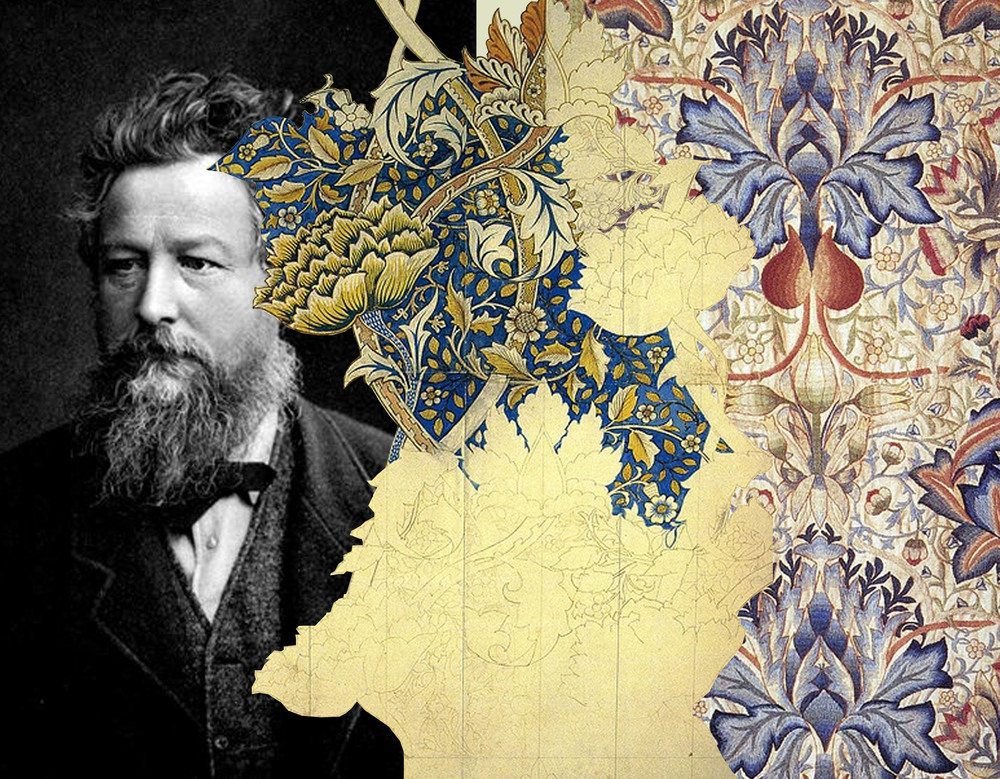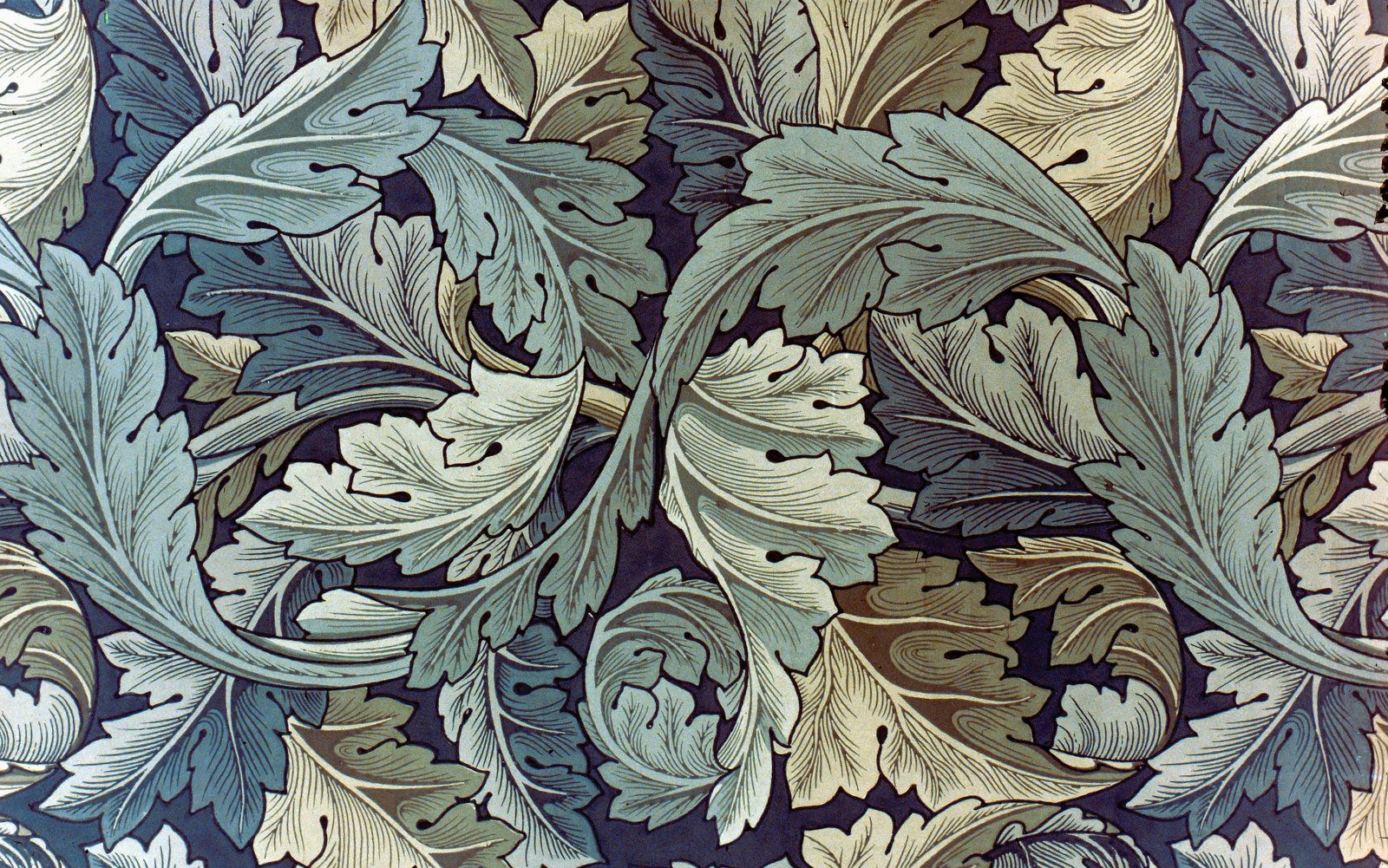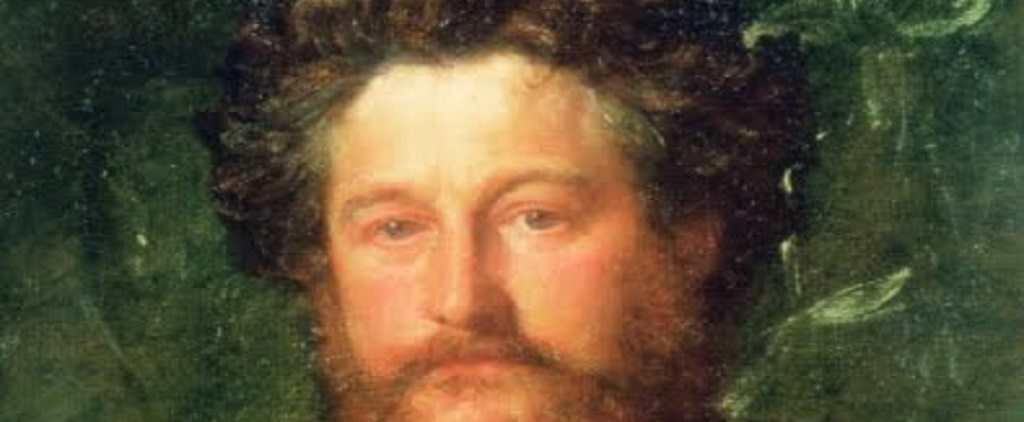[dropcap style=”font-size:100px;color:#992211;”]C[/dropcap]onsidering a single object the ‘Bullerswood Carpet’ held at the V&A in London Natalie Andrews looks at the seeds of modernism planted by the socialist thinker, designer and artist William Morris whose work has been highly influential on the forming of the modernist mind-set.
_________________________________________________________
The Seeds of Modernist thought
The ‘Bullerswood Carpet’ by Morris and Dearle (Morris’s assistant) is a good example of the sort of design that Morris believed would enhance the living conditions of people in general bringing handmade, carefully executed objects and furnishings into the private space of individuals and their families.

William Morris and some of his designs.
Morris born in 1834 and living until 1896 (age 62) saw the beginnings of modernism, notably the effects of the industrial revolution and the beginnings of Impressionism.
I do not want art for the few,
any more than I want education for the few,
or freedom for the few’
Throughout his life he developed simultaneously an enthusiasm for making and creative thought and an anti-capitalist attitude encompassing a contempt for snobbish hierarchy especially in the arts, this was one of the important tenants of the arts and crafts movement which he was involved in.

Bullerswood Carpet, William Morris and John Henry Dearle, about 1889, England. Museum no. T.31-1923. © Victoria and Albert Museum, London
“Along with Morris’s social awakening came a developing of his ideas for combining the skills of the artist with those of the craftsman, with equal recognition for the talents of both. Though the term Arts and Crafts Movement was not coined until 1887, the main tenet of breaking down the hierarchy of art, which elevates painting and sculpture, above that of, traditional crafts and design, were championed by Morris, Burne-Jones, and Ruskin much earlier; some consider the Red House as being the first application of these theories. Key to the ideas of the Arts and Crafts movement was that artistic or beautiful objects should not be just for those who could afford them, Morris proclaimed, ‘I do not want art for the few, any more than I want education for the few, or freedom for the few’..,” Kenny McEwan, William Morris and The Arts and Crafts Movement, accessed at http://www.redflag.org.uk/frontline/eleven/11morris.html on 19th March 2017.
The Carpet itself is a celebration of nature and traditional craft techniques there is a sense of abundance and plenty from the stylised animals and the interwoven branches and leaves, a clear influence from the past is also evident (medieval pattern) and this is an interesting trait of both the arts and crafts movement and Morris himself. While modernism was birthing avant-gardism which would see Impressionism moving and transforming through cubism, expressionism towards ever greater forms of abstraction and conceptualism, Morris and the movements he championed emphasised the importance of tradition.
Avant-gardism embraced rapid change and innovation through experimentation and was in part always antagonistic to established authority and taste (all aforementioned modernist movements were attacked by the opinion makers of the time even Impressionism the name coming from the insult of an art critic who declared he saw only impressions of paintings!) Despite a more positive relationship with the idea of the past Morris was never without criticism for contemporary life and should not be considered a bourgeois stick in the mud,
“Our business[…] is the making of Socialists, i.e. convincing people that Socialism is good for them and is possible. When we have enough people of that way of thinking, they will find out what action is necessary for putting their principles in practice. Therefore, I say, make Socialists. We Socialists can do nothing else that is useful.” William Morris,..Mackail, J.W. (1901). The Life of William Morris: Volume One (new ed.). London, New York, and Bombay: Longmans, Green & Co.

The Arts and crafts movement and Morris maintained the need for people to have an un-alienated relationship to their own creativity and the general importance on the cultivation of living spaces which in part acknowledged a connection to the past. The faith that Morris placed in art as a transformative practice echo’s the values of the key modernist movements where the ultimate goal was that ideas would be taken up by the mainstream and therefore improve society via the enrichment of individuals.
“The ideology of modernism had several sources. One of the earliest was the English artist William Morris, whose writings formed the basis for the arts and crafts movement. Morris advocated a return to well-made, handcrafted goods instead of mass-produced, poor quality machine-made items. In his famous statement, “Have nothing in your house that you do not know to be useful, or believe to be beautiful,” Morris outlined the modern belief that utility was as important as beauty,” Anthony S. Denzer, Ph.D. ‘Master of Modernism, accessed at, http://www.mastersofmodernism.com on 19th March 2017
This would be taken up notably in the values of the Bauhaus where these values were combined with integrating modern forms of production which had come out of the industrialization of Europe,
“Art itself cannot be taught, but craftsmanship can. Architects, painters, sculptors are all craftsmen in the original sense of the word. Thus it is a fundamental requirement of all artistic creativity that every student undergo a thorough training in the workshops of all branches of the crafts,” Walter Gropius As quoted in Paul Klee, 1879-1940 (2000) by Susanna Partsch,

The End of the Bauhaus. Iwao Yamawaki, collage, 1932
The Bauhaus a German project running from 1919 to 1933 eventually fell afoul of Nazism and was closed on the orders of Hitler who suspected many of the famous teachers and students of left wing and liberal sympathies. The legacy of Morris and the ideals of movements like ‘arts and crafts’ and the ‘Bauhaus’ remain a potential awaiting reactivation in a possible utopia of the future.

Natalie Andrews is an artist working with a range of mediums, she has shown her work at the Hoxton Arches in London and is currently working on a number of 3d works alongside painting exploring the links between painting and sculpture;
“I am interested in the way that we relate to one another and with space, how the environments we inhabit structure and dictate these relationships and create both opportunities for emancipation but also the deep alienation and separateness.”




















